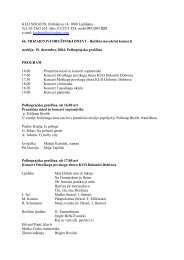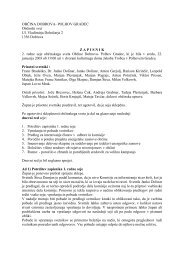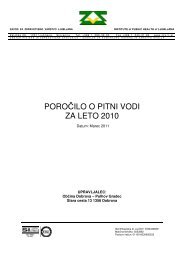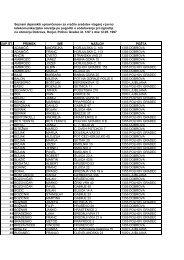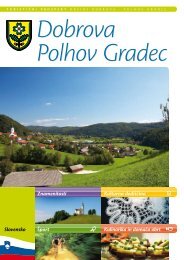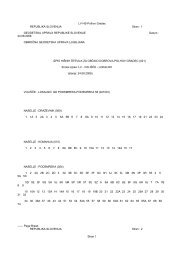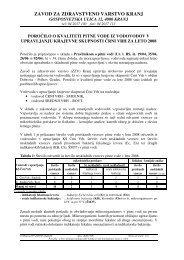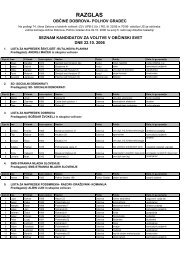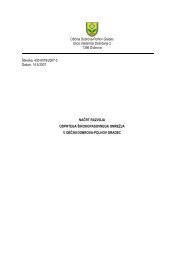Sports - Občina Dobrova - Polhov Gradec
Sports - Občina Dobrova - Polhov Gradec
Sports - Občina Dobrova - Polhov Gradec
You also want an ePaper? Increase the reach of your titles
YUMPU automatically turns print PDFs into web optimized ePapers that Google loves.
TOURIST BROCHURE O F T H E M U N I C I P A L I T Y O F D O B R O V A - P O L H O V G R A D E C<br />
<strong>Dobrova</strong><br />
<strong>Polhov</strong> <strong>Gradec</strong><br />
Sights Cultural heritage<br />
English <strong>Sports</strong> Gastronomy and crafts
Attractions<br />
Events<br />
The Daphne blagayana: a twice discovered<br />
flower. The precedence and<br />
name after its<br />
discoverer was<br />
granted to Count<br />
Blagaj from<br />
<strong>Polhov</strong> <strong>Gradec</strong>.<br />
Since 1898 the<br />
first protected<br />
plant in the region<br />
of Carniola<br />
along with the<br />
Edelweiss and<br />
at the time due<br />
to a visit of the<br />
Saxon king was<br />
also called the king’s flower.<br />
The Babčar encampment in Babna<br />
Gora: a cone-shaped steep rock,<br />
supposingly a fortification in Turkish<br />
times, linked with women’s courage<br />
in their defence against the Turks.<br />
The Days of Honey:<br />
a professional exhibition<br />
event with cultural<br />
acti vities; lectures<br />
and tastings<br />
The Evening under<br />
Vetrnik: a regional<br />
competition for diatonic<br />
accordion hosted in<br />
the Corn-rack in Babna<br />
Gora and a selection<br />
competition for the<br />
Golden Accordion Sound<br />
in Ljubečna<br />
The Gathering on Gora: choirs from<br />
far and near participate in this traditional<br />
event on Gora or Lovrenc.<br />
The Day under Lovrenc: a tourist<br />
event with demonstration of traditional<br />
country husbandry<br />
Blagaj’s Days: a competitive salesexhibition<br />
event based on a yearly<br />
newly selected culinary theme from<br />
Attractions and events<br />
A gorge with precipitous faces near<br />
the farmhouse Plaznik by Šentjošt.<br />
The archeological site on the<br />
Marinčeva planina in Planina nad<br />
Horjulom with finds dating from<br />
late pre-historical times. The found<br />
objects are kept in house number 5.<br />
The Corn-rack in Babna Gora,<br />
transported to the village from Črni<br />
Vrh, which hosts the yearly competition<br />
for diatonic accordion – what<br />
is an ingenious example of the fresh<br />
role of corn-racks. Picnics and social<br />
events may also be organized inside<br />
– marketing possibilities.<br />
Butajnova’s attraction is a churnof-milk-shaped<br />
old well from the<br />
beginning of the 20th century.<br />
The lime-tree by the Manor House<br />
of <strong>Polhov</strong> <strong>Gradec</strong> of 5,5m in diameter,<br />
the remains of the former castle park,<br />
planted with various tree species.<br />
the local area<br />
Mozart’s Days: a festival for classical<br />
music, choral and solo singing<br />
lovers; once a month<br />
St. Nicholas’ Fair: a sales-exhibition<br />
event on the popular December feast<br />
with the participation of adjoining<br />
elementary schools in particu-<br />
lar; the Salami Festival (‘salamijada’):<br />
a tourist-culinary event with the selection<br />
of the highest-quality made<br />
salami; tasting<br />
The Night Hike up Grmada: in remembrance<br />
of the recognition of<br />
the Slovenian state (in January, on<br />
the Friday closest to the full moon)<br />
While the <strong>Polhov</strong> <strong>Gradec</strong> area unveals itself through its local place names, such as Dvor, <strong>Gradec</strong>, Pristava, Škofija, referring<br />
to the nobility of the lords, is the <strong>Dobrova</strong> part with its place names an image of our nature. Not only <strong>Dobrova</strong> – which<br />
with just a tiny bit of imagination can be reminiscent of grassy meadows, woodlands – but also the villages Podsmreka<br />
(smreka – eng. pine tree), Brezje (breza – eng. birch), Gabrje (gaber – eng. beech tree), Hruševo (hruška – eng. pear tree),<br />
Hrastenice (hrast – eng. oak tree) reveal themselves with names of those tree species, our Slovenian land is rich of. Both<br />
areas contribute in their own way and form a whole, without which Slovenia would be a poorer place.<br />
Published by the Municipality of <strong>Dobrova</strong>-<strong>Polhov</strong> <strong>Gradec</strong> • Text on the municipality by Milka Bokal • Data collected by Helena Čuk • Photographs: the municipality’s<br />
archive • Recipe sources: Granny’s kitchen (Babičina kuhinja), Elementary School <strong>Polhov</strong> <strong>Gradec</strong>; Cheesemaking Orešnik (Sirarstvo Orešnik) • Translation by Gorec d. o. o. •<br />
Design and prepress by Fanfara, d. o. o. • Print: <strong>Dobrova</strong>, 2007
Larger settlements<br />
The Municipality of <strong>Dobrova</strong>-<strong>Polhov</strong> <strong>Gradec</strong><br />
The <strong>Polhov</strong> <strong>Gradec</strong> Hills and <strong>Dobrova</strong>’s surrounding countryside, a concatenation<br />
of fields, villages, forests, little churches and farmhouses<br />
<strong>Dobrova</strong><br />
Situated at the bifurcation of the<br />
route towards Horjul and <strong>Polhov</strong><br />
<strong>Gradec</strong>, it is the administrative centre<br />
of the municipality. According to folk<br />
tradition the settlement was named<br />
after a thousand-year oak tree, felled<br />
in 1888. The names of the nearby hill<br />
Gradišče and the farmer Gradišnik<br />
suggest an Oldslavic settling. The<br />
Church of St. Mary, where several<br />
prayers were answered, attracted numerous<br />
worshippers and was as such<br />
an age-long vivacious centre of pilgrimage.<br />
Also<br />
Jožef Poklukar,<br />
Ph.D.,<br />
the Head of<br />
the Carniola<br />
Region, had<br />
a villa of his<br />
own in <strong>Dobrova</strong>. Slovenian impressionists<br />
are said to have sought motifs<br />
in its surroundings. Because you can<br />
subscribe to a theatre subscription<br />
series and due to organized choral<br />
singing and Lady Day masses <strong>Dobrova</strong><br />
up to this day holds a special<br />
position in the municipality.<br />
<strong>Polhov</strong> <strong>Gradec</strong><br />
a picturesque village in the heart of<br />
the <strong>Polhov</strong> <strong>Gradec</strong> Hills, is a world of<br />
larger and smaller cumulous hillocks<br />
with solitary farms amidst green forests<br />
and concealed churches amid the<br />
latter. This world has been marked by<br />
a turbulent past and not spared by<br />
nature. Sources write the following<br />
on the earthquake in 1348: the earth<br />
shook for forty days; the earthquake<br />
in 1511 destroyed the castle on the<br />
rising ground above the village. At<br />
that point <strong>Polhov</strong> <strong>Gradec</strong> entered<br />
social history, as it marked itself as<br />
the first focal point of the all-Slovenian<br />
peasant rising in year 1515. It has<br />
also left a significant mark on cultural<br />
history. It was mentioned by Primož<br />
Trubar, is one of the few settlements<br />
referred to<br />
in the poetry<br />
almanac<br />
the Kranjska<br />
čbelica from<br />
1832, Cankarappa-<br />
rently deemed it the most beautiful<br />
Slovenian village. <strong>Polhov</strong> <strong>Gradec</strong> is<br />
culturally alive to this day. Numerous<br />
choirs, an alpine, bowls’, bobbin lace<br />
association, cultural, tourist, sports’<br />
and other associations, folkloristic<br />
groups, the local museum and other<br />
activities give the village a lively pulse.<br />
Plenty of events, among them the<br />
Days of Honey, the Evening under<br />
Vetrnik, the Gathering on Gora, St.<br />
Nicholas’ fair, Mozart’s days, Blagaj’s<br />
days, classical music concerts, the Salami<br />
Festival, occasional exhibitions<br />
and other periodic events in the Manor<br />
House of <strong>Polhov</strong> <strong>Gradec</strong> and the<br />
Jakob Trobec Cultural Centre entice<br />
numerous visitors from far and near.<br />
Črni Vrh<br />
to this day fascinates with those dark,<br />
large pine trees, which supposingly<br />
gave the village its name. The border<br />
between the Škofja Loka and <strong>Polhov</strong><br />
<strong>Gradec</strong> world runs along the hill-ridges,<br />
an ancient freight route once ran<br />
through the valleys among them. Its<br />
geographic position places Črni Vrh<br />
among the most interesting hiking<br />
and cycling points in the <strong>Polhov</strong> <strong>Gradec</strong><br />
Hills. The centre of the village with<br />
the large Church of Saint Lawrence,<br />
built after the earthquake in 1895,<br />
is situated underneath the hill. The<br />
church’s main altar was created in<br />
the Toman workshop from Ljubljana,<br />
the side altars and pulpit by Valentin<br />
Šubic. Several carved and other works<br />
are redolent of one of the village’s first<br />
priests, the universally active Bruno<br />
Ortner, who moved to Črni Vrh at<br />
the end of the 18th century upon<br />
the dissolution of the monastery in<br />
Bistra. A chapel dating from 1850 and<br />
located in the village centre is of great<br />
importance to the people. The three<br />
naves stable by Omejc, Črni Vrh 58, is<br />
definitely worth seeing. It is only but<br />
one among several similar monuments<br />
to the peasantry’s hard-work<br />
and wise thriftiness. This is a world<br />
of hard-working people, who, along<br />
their everyday work on their farms<br />
and elsewhere, are capable to join<br />
forces in cultural, social and generally<br />
beneficial activities, also in the realm<br />
of the cultural and tourist association.<br />
Each year, St. Nicholas and his accompaniment<br />
betake themselves through<br />
the village. The bonfire celebrations<br />
on Sovov grič on the Slovenian Statehood<br />
Day have become traditional<br />
as well.<br />
Šentjošt<br />
is a wayside-centred ridgy village situated<br />
in the far southwest part of<br />
the <strong>Polhov</strong> <strong>Gradec</strong> Hills; the centre of<br />
economic, cultural and social life of<br />
the village itself and of its immediate<br />
surroundings, which throughout the<br />
year flows through its cultural, sports,<br />
alpine and students’ association and<br />
even a yacht club. The motocross<br />
race in Planina nad Horjulom complements<br />
all other sports activities,<br />
including skiing and cycling. The village<br />
has two churches, the same as<br />
Dvor. The older St. Jost’s Church dates<br />
from the 13th century and the settlement<br />
itself got its name after it. The<br />
bell tower holds two bells of respectable<br />
age: the older one, dated from<br />
1354, was cast by the bell-founder Vivencius<br />
and is considered the oldest<br />
bell in Carniola; the other one dates<br />
from around 1400. The other church,<br />
the Church of St. John the Evangelist,<br />
is the parish church and the oldest<br />
date within it dates from 1664. The<br />
church art in Šentjošt also lives out of<br />
the present. The martyrs’ chapel with<br />
all succursal churches’ patrons was<br />
created by the first <strong>Polhov</strong> <strong>Gradec</strong><br />
academic sculptor Edo Dolinar from<br />
Briše pri <strong>Polhov</strong>em Gradcu and was<br />
erected in commemoration of all victims<br />
of communism and World War<br />
Two from this area. The window glasses<br />
were created by Marko Jerman.<br />
The Municipality of <strong>Dobrova</strong>-<strong>Polhov</strong> <strong>Gradec</strong><br />
1
Municipality of <strong>Dobrova</strong> - <strong>Polhov</strong> <strong>Gradec</strong><br />
6<br />
7 30<br />
Šentjošt<br />
18<br />
27<br />
19<br />
28<br />
Butajnova<br />
Črni Vrh<br />
24<br />
23<br />
8<br />
<strong>Polhov</strong><br />
<strong>Gradec</strong><br />
20<br />
9<br />
10<br />
25<br />
1<br />
5
17<br />
16<br />
21<br />
35<br />
2<br />
31<br />
13<br />
4<br />
Where<br />
are we?<br />
32<br />
1 km<br />
14<br />
26<br />
<strong>Dobrova</strong><br />
34<br />
3<br />
11<br />
15<br />
36<br />
22 33<br />
12 29<br />
Legend<br />
The <strong>Polhov</strong> <strong>Gradec</strong> Hiking Trail<br />
Approaches to the <strong>Polhov</strong> <strong>Gradec</strong> Hiking Trail<br />
Cycling routes 1-7<br />
Peaks<br />
End of the round cycling route<br />
Scale
2<br />
Due to its extraordinary cultural,<br />
scenic, architectural<br />
and historical particularities,<br />
the Manor House of <strong>Polhov</strong> <strong>Gradec</strong><br />
complex with the following<br />
units: the manor house, the<br />
Neptune’s well and the park is – like<br />
the church in Dvor - a cultural monument<br />
of national importance.<br />
The park is one of the few preserved<br />
axial parks that are surrounded<br />
by geometrically set hedge’s edges.<br />
The whole complex – together<br />
with its olden lime - tree, severalstoried<br />
Baroque manor house at<br />
the same spot of an olden fortification<br />
and the Neptune’s well - is a<br />
rarely preserved monument of a<br />
Baroque residence, which in the<br />
19th century served as domicile of<br />
the renowned Blagaj family. The<br />
Daphne blagayana, which grows on<br />
Gora or Lovrenc, was named after<br />
Count Blagaj (1786-1858). The current<br />
architectural appearance of<br />
this complex with the well, English<br />
tower with a clock, castle and the<br />
castle baroque chapel with skilfully<br />
shaped stucco works is largely<br />
owing to Mark Anton Kunstel I. and<br />
dates from the second half of the<br />
17th century.<br />
Particular attention has recently also<br />
been shifting to the periphery units,<br />
among them to the water catchment<br />
V lipcah: the word Victor, inscribed<br />
on one of its walls, apparently serves<br />
as proof of a French military presence<br />
at the time of Napoleon’s provinces.<br />
The building by the manor house<br />
with traces of a sun clock – a building<br />
for which folk tradition has preserved<br />
the idea of it having once been a<br />
church - still has to be handled by re-<br />
Cultural heritage<br />
The Manor House of <strong>Polhov</strong> <strong>Gradec</strong><br />
Present within the past<br />
Cultural heritage<br />
searchers. The pillars overhanging<br />
from the frontage are similar to those<br />
on the outer part of the Church of St.<br />
Peter in Dvor. The first sun clock,<br />
which is also better preserved, is situated<br />
on the building across the manor<br />
house, the residence of the former<br />
castellan.<br />
The modern manor house hosts several<br />
local and out-of-municipality<br />
events. There is a wedding hall; the<br />
local museum, housing ethnographic<br />
heritage, castle-life items<br />
and also precious finds from the<br />
site in the place itself and Gora or<br />
Lovrenc, is permanently located in<br />
the building.<br />
The obelisk-shaped Blagaj monument<br />
on the foothills of Lovrenc is<br />
located roughly 10 minutes away<br />
from the Manor House of <strong>Polhov</strong><br />
<strong>Gradec</strong>. It was erected in commemoration<br />
of the visit of the Saxon<br />
King Friedrich August II., who in<br />
1838 came to admire the newly-discovered<br />
yellow ‘jožefca’ – the<br />
Daphne blagayana.<br />
Kalvarija or Stari Grad (Old Castle)<br />
is a rising ground above <strong>Polhov</strong><br />
<strong>Gradec</strong>, which can be ascended on<br />
a route with 14 renovated chapels<br />
of the Stations of the Cross, each<br />
chapel holding a cast of one of<br />
France Gorše’s plastics inside. The<br />
figures of men with hats and<br />
women with kerchiefs are a reflection<br />
of the simple, typical Slovenian<br />
Lent atmosphere.<br />
Practical tips<br />
There is a wedding hall in the Manor<br />
House of <strong>Polhov</strong> <strong>Gradec</strong>;<br />
you can also get married in the pavilion<br />
in the Manor House’s park.<br />
After the ceremony the wedding<br />
guests enjoy themselves in the antique<br />
atmosphere underneath the<br />
magnificent castle lime- tree. The<br />
Manor House of <strong>Polhov</strong> <strong>Gradec</strong><br />
hosts numerous events throughout<br />
the year. You may rent the<br />
premises and the park for cultural<br />
and other events, which do not interfere<br />
with a cultural monument<br />
of the 1st category.<br />
Information:<br />
1 Polhograjska<br />
graščina<br />
<strong>Polhov</strong> <strong>Gradec</strong> 61,<br />
1355 <strong>Polhov</strong> <strong>Gradec</strong><br />
Tel: 01 364 56 94<br />
e-mail:<br />
p.grascina@volja.net<br />
www.grad-polhovgradec.si<br />
ORGANIZED TOURS<br />
2 Gothic Church of St.<br />
Peter in Dvor (guided<br />
tour 45 minutes)<br />
Cultural-historical<br />
heritage of <strong>Polhov</strong><br />
<strong>Gradec</strong> (guided tour 60<br />
minutes)<br />
The Manor House of<br />
<strong>Polhov</strong> <strong>Gradec</strong> / local<br />
museum (guided tour<br />
45 minutes). The whole<br />
organized tours’ programme,<br />
which includes<br />
all three above-mentioned<br />
tours, is of 3 hour<br />
duration.
Church art monuments<br />
The Church of St. Peter in Dvor is<br />
a monument of national significance.<br />
Its construction began in 1525<br />
and it is said to have been an important<br />
developmental link in the<br />
fine arts between Gothic Art and<br />
the Renaissance. The ideational<br />
approach with different portrayals<br />
of Apostle Peter shows the efforts<br />
to express appurtenance to Rome,<br />
the Catholic Church. Recent research<br />
has proven the folk memory of<br />
the Turkish invasions, which attributes<br />
a significant fortress role to<br />
the church. The first public inscription<br />
in Slovenian can be found on<br />
the coffered ceiling dating from<br />
1577. A recent finding has revealed<br />
an extraordinary variety of origins<br />
of the building blocks, from the Castle<br />
of <strong>Polhov</strong> <strong>Gradec</strong> above the<br />
village, which had been demolished<br />
shortly before the start of the construction,<br />
to stones from modern<br />
Germany. The name of the builder<br />
Gregorij Ruckhenstain is engraved<br />
with a chisel above the main portal<br />
with various figures. The adorable<br />
six small golden altars, two<br />
Metzinger’s paintings, sculptures by<br />
the carving family Facij from <strong>Polhov</strong><br />
<strong>Gradec</strong> on the main altar and the<br />
frescoes are only but a few of all the<br />
valuables, hidden in this jewel of<br />
Cultural heritage<br />
3
4 Cultural heritage<br />
church art. The perhaps heartiest of<br />
all scenes on the frescoes is the one<br />
of the Holy Family, depicting Mary<br />
and Joseph holding Jesus, the small<br />
child placed in-between them, by<br />
his hands.<br />
The parish church in <strong>Dobrova</strong>, called<br />
Mary in hazel grove, is, according<br />
to Valvasor, one of the oldest churches<br />
in Carniola, and famous especially<br />
for ‘an abundance of miracles’.<br />
The hazel bush, linked with the formation<br />
of this great pilgrimage centre<br />
and by which, according to tradition,<br />
in 970 the original chapel was<br />
built, still grows by the church. The<br />
present-day church was completed<br />
in 1716 by Gregor Maček. The main<br />
architectural units of this church are<br />
the octagonal-shaped nave and<br />
presbytery, covered by two cupolas,<br />
a light well and four side-altars. The<br />
large black plaque acts as a reminder<br />
of the consecration in 1747. The<br />
Lady Day masses between Assumption<br />
and the Nativity of Our Lady<br />
(from 15th August till 8th September)<br />
are a distant echo of those large<br />
pilgrimages. Same as before, the pilgrims<br />
from neighbouring parishes<br />
arrive to the final celebration in a<br />
procession.<br />
The Church of Mary’s birth, the<br />
parish church in <strong>Polhov</strong> <strong>Gradec</strong>,<br />
is famous for its eventful, picturesquely<br />
fretted golden Baroque altar<br />
dating from 1746, with a multitude<br />
of angelic and plant figures,<br />
Cultural heritage<br />
made by the family Facij, locals of<br />
Italian descent. Valentin Metzinger’s<br />
(1699-1759) paintings, the best<br />
known of which being Joseph’s death,<br />
are valuable objects of this<br />
church.<br />
JOŽE PLEČNIK AND IVAN VURNIK<br />
The great Slovenian architects Jože Plečnik (1872-1957) and<br />
Ivan Vurnik (1884-1971) left their marks with their works also<br />
in the <strong>Dobrova</strong> and <strong>Polhov</strong> <strong>Gradec</strong> area. The native Ivan Dolinar<br />
from <strong>Dobrova</strong> in 1954 made four chandeliers for the parish<br />
church in <strong>Dobrova</strong>, which were based on Plečnik’s blueprints.<br />
The chandelier in the vestibule of the Mary’s sisters’<br />
convent in <strong>Dobrova</strong> is Plečnik’s as well. The blueprint for the<br />
chapel in Briše pri <strong>Polhov</strong>em Gradcu was done by one of his<br />
pupils. The National Liberation War (NOB) monument in<br />
front of the Jakob Trobec Cultural Centre in <strong>Polhov</strong> <strong>Gradec</strong> is<br />
also a work of his. In 1961, Plečnik’s contemporary Ivan Vurnik<br />
did the blueprint for the organ casing in the parish church in<br />
<strong>Polhov</strong> <strong>Gradec</strong> and for the interior of the presbytery in the<br />
nearby Church of St. Catherine on Topol-Katarina.
HIKING<br />
The <strong>Polhov</strong> <strong>Gradec</strong><br />
Hiking Trail in various<br />
stages:<br />
<strong>Polhov</strong> <strong>Gradec</strong> (The<br />
Pratkar Inn)–Grmada–<br />
Tošč (on the peak)–Selo<br />
(the open-door farm Pri<br />
Ogrincu)–Črni Vrh–<br />
Smolnik–Božna–<strong>Polhov</strong><br />
<strong>Gradec</strong> (6 hours)<br />
<strong>Polhov</strong> <strong>Gradec</strong>–Smolnik–Črni<br />
Vrh–Pasja<br />
raven (Na Koširjevem or<br />
Pri Zagričarju)–Sivka<br />
(on the peak)–Srednji<br />
Vrh (Na Rusovem)–Setnik<br />
(Na Žulevem)–Mali<br />
vrh–Gora (Pri Logarju<br />
or at the church)–<strong>Polhov</strong><br />
<strong>Gradec</strong> (7 hours)<br />
<strong>Polhov</strong> <strong>Gradec</strong>–Praproče–Mali<br />
vrh–Setnik–<br />
Butajnova–Kožljek (on<br />
the top)–Koreno (Pri<br />
Lenartu)–<strong>Polhov</strong> <strong>Gradec</strong><br />
with Kalvarija (the<br />
walls in front of the<br />
chapel) (6 hours and a<br />
half)<br />
<strong>Polhov</strong> <strong>Gradec</strong>–Zavrh–<br />
Ključ (on the peak or at<br />
the Partisan refuge)–<br />
Babna Gora (Pri<br />
Glažarju)–Grmada (on<br />
the peak)–<strong>Polhov</strong><br />
<strong>Gradec</strong> (7 hours). All<br />
places where you can<br />
receive a stamp, are<br />
stated in brackets.<br />
The Šentjošt round<br />
trail: Šentjošt–Butajnova–Planina–Suhi<br />
Dol–Smrečje–Šentjošt<br />
(5 hours and 15 minutes)<br />
The outset of the Petač<br />
graben–Smolnik–Črni<br />
Vrh–Pasja ravan (2<br />
hours). The signpost for<br />
Smolnik is about 40m<br />
after the branching-off<br />
the road into the Petač<br />
graben (Petačev graben)<br />
and the bridge on the<br />
right side by the road to<br />
Črni Vrh<br />
Briše (Pri Korošcu)–<br />
Koreno (1 ura).<br />
<strong>Sports</strong><br />
<strong>Sports</strong> and recreation<br />
To Polhograjska<br />
Grmada – so alpine<br />
and so close<br />
From the low-land around <strong>Dobrova</strong><br />
Grmada (899 m) can be seen as a<br />
motioned ridge mountain hill in<br />
the heart of the <strong>Polhov</strong> <strong>Gradec</strong><br />
Hills. Folk imagination during the<br />
period of the Illyrian provinces adjudged<br />
a similarity between its<br />
upper outline and King Louis XIV.’s<br />
nose. Nowadays, however, it is better<br />
known for its variety of plants<br />
and motioned terrain, giving it an<br />
alpine look. Because of a rather easy<br />
access to the so to say steep alpine<br />
world near Ljubljana and a reasonable<br />
above-sea level the hill is very<br />
popular with visitors, which is aided<br />
also by the location of the peak,<br />
running on the border of two municipalities,<br />
the Municipality of <strong>Dobrova</strong>-<strong>Polhov</strong><br />
<strong>Gradec</strong> and the Municipality<br />
of Medvode. The Grmada<br />
thus connects two areas, the <strong>Polhov</strong><br />
<strong>Gradec</strong> valley and the Medvode<br />
side. For one night it also becomes<br />
a famous hiking centre in central<br />
Slovenia: that is due to the traditional<br />
night hike each January,<br />
closest to the full moon.<br />
Approaches: several well-marked<br />
trails from different starting points<br />
in the <strong>Polhov</strong> <strong>Gradec</strong> valley lead to<br />
the top of the hill, the first one from<br />
the village Belica along the Baška<br />
ravine. Another trail runs from Dvor<br />
via Kucelj and after a few clearings is<br />
joined by the trail arriving from <strong>Polhov</strong><br />
<strong>Gradec</strong> past Pratkar. The one<br />
trail, which tourists can combine<br />
with a visit to <strong>Polhov</strong> <strong>Gradec</strong>, is very<br />
popular. From Pratkar the trail runs<br />
along the forest slope, passes the<br />
recently completed Alpine Association<br />
Blagajana’s mountain refuge,<br />
reaching the village Ravnek and<br />
then turns to the right past a quarry<br />
reaching a saddle with a crossing,<br />
not far from the Hunting lodge<br />
with another crossing. The trail<br />
ascending the slope leads along<br />
Grmada’s hogsback and is in certain<br />
places steep and rocky, while the<br />
trail to the right side is less steep<br />
and therefore less difficult. From<br />
the peak there is an exquisite view<br />
of central Slovenia and also of the<br />
Julian and Kamnik-Savinja Alps, Ljubljana,<br />
Notranjska with Snežnik and<br />
Nanos. Many hikers descend Grmada<br />
along the Maček graben, a picturesque<br />
valley with water, flowing<br />
over numerous dams.<br />
Inns can also be found on the way.<br />
Those descending to Medvode’s<br />
side can refresh themselves in the<br />
tourist farm on Gonte; on the other,<br />
<strong>Polhov</strong> <strong>Gradec</strong> side, in the village<br />
Setnica near St. Ursula’s Church,<br />
precisely under Grmada, is the<br />
excursion farm Pri Mehačku. Cate-<br />
<strong>Sports</strong> and recreation<br />
5
6<br />
ring is available in <strong>Polhov</strong> <strong>Gradec</strong> as<br />
well: in Pograjski Dom, situated on<br />
the route towards Črni Vrh, or in<br />
the centuries-old inn Pratkar. Parking<br />
is best provided for in <strong>Polhov</strong><br />
<strong>Gradec</strong>.<br />
Walking time: from all sides one<br />
hour and a half up to two hours.<br />
Elevation difference: approximately<br />
510m.<br />
<strong>Sports</strong> and recreation<br />
To Tošč – the woods lure<br />
Tošč (1021m) can be ascended on<br />
two trails. The first trail runs from<br />
<strong>Polhov</strong> <strong>Gradec</strong> along the Maček<br />
Graben, leading to the saddle Gonte<br />
with the tourist farm. The broad<br />
trail gradually narrows, therefore it<br />
is best to park at the beginning of<br />
the Maček graben. From Gonte the<br />
trail branches off to the left and via<br />
Mali Tošč leads to the peak, partly<br />
hidden behind trees. The second<br />
possible trailhead is in Selo, where<br />
you can refresh yourself at the<br />
open-door farm Pri Ogrincu. The<br />
trail leads past the Church of Saint<br />
Jedrta through the forest to the<br />
top.<br />
Walking time: from Maček graben<br />
2 hours. Elevation difference:<br />
approximately 620m.<br />
To Gora – Lovrenc,<br />
the treasure and Daphne<br />
blagayana mountain<br />
<strong>Sports</strong><br />
Lovrenc (824m) or by locals called<br />
Gora is a solitary mountain, protecting<br />
<strong>Polhov</strong> <strong>Gradec</strong> with its magnificent<br />
spine. The summit with St.<br />
Lawrence’s Church dating from the<br />
beginning of the 16th century has<br />
attracted visitors from old, also<br />
through its in some ways mysterious<br />
past. In that regard, the following<br />
piece of information is important:<br />
there was a building site here in prehistorical<br />
times and from 1868 till<br />
1973 four archeological sites - treasures<br />
were discovered.<br />
The Daphne blagayana habitats are<br />
the second Gora’s attraction. No<br />
longer accessible to the average hiker,<br />
they were however probably<br />
more spread in the past, which is<br />
indirectly demonstrated by the famous<br />
Blagaj monument on the foothills<br />
of Gora.<br />
Approaches: most hikers ascend<br />
Gora from the Beekeeping home<br />
on a rather steep, but shadowy trail,<br />
leading to the ridge to the farmhouse<br />
Pri Logarjun with basic catering<br />
provided during weekends. The second<br />
approach is on the road from<br />
<strong>Polhov</strong> <strong>Gradec</strong> to the village Briše.<br />
Just before reaching the village, you<br />
must turn right towards Praproče<br />
and before entering that village park<br />
by the corn-rack. The guidepost<br />
points to the right. Roughly at the<br />
half-way point of the trail, the trail<br />
leads to the ridge with a barrier,<br />
with a branching-off to the left<br />
onto a more difficult and steeper<br />
trail. The main trail also narrows at<br />
this point.<br />
And refreshing possibilities upon<br />
arriving to the valley: the excursion<br />
farm Pri Bitencu in Briše and the<br />
inns Pograjski dom and Pri Pratkarju<br />
in <strong>Polhov</strong> <strong>Gradec</strong>.<br />
Walking time: from the Beekeeping<br />
home 1 hour, the path through<br />
Briše 1 hour and a half. Elevation<br />
difference: approximately 420 m.<br />
<strong>Polhov</strong> <strong>Gradec</strong> (Čebelarskidom)–Gora–Lovrenc<br />
(1 ura).<br />
<strong>Polhov</strong> <strong>Gradec</strong>–Praproče–Gora–Lovrenc<br />
(1 ura 30 min).<br />
<strong>Polhov</strong> <strong>Gradec</strong>–Setnica–<br />
Grmada (1 ura 30 min).<br />
<strong>Polhov</strong> <strong>Gradec</strong>–Ravnek–<br />
Grmada (1 ura 30 min).<br />
Brezje–Ključ (20 min).<br />
Stranska vas–Toško<br />
čelo–Topol (Katarina)–<br />
Grmada–Tošč–Selo–<br />
Črni Vrh (7 ur).<br />
Žirovnikov graben–<br />
Belo–Topol (Katarina),<br />
(1 ura 30 min).<br />
Žirovnikov graben–Seničar–Ravnikar–Katarina<br />
(1 ura 30 min).<br />
CYCLING ROUTES<br />
Vrhovci–Bokalci–<br />
Stranska vas–Šujica.<br />
<strong>Dobrova</strong>–Stranska<br />
vas–Toško čelo–Topol<br />
(Katarina)–The Žirovnikov<br />
graben (Žirovnikov<br />
graben)<br />
Briše (pri Korošcu)–<br />
Koreno.<br />
<strong>Polhov</strong> <strong>Gradec</strong>–Setnica–<br />
Ravnek–<strong>Polhov</strong> <strong>Gradec</strong>.<br />
<strong>Polhov</strong> <strong>Gradec</strong>–Kurja<br />
vas–Šentjošt–Vrzdenec–Horjul–<strong>Dobrova</strong>.<br />
<strong>Polhov</strong> <strong>Gradec</strong>–Setnik<br />
(Zalog)–Butajnova–<br />
Kurja vas–<strong>Polhov</strong><br />
<strong>Gradec</strong>.<br />
<strong>Polhov</strong> <strong>Gradec</strong>–Petačev<br />
graben–Črni Vrh–<strong>Polhov</strong><br />
<strong>Gradec</strong>.<br />
<strong>Polhov</strong> <strong>Gradec</strong>–Potrebuježev<br />
graben–Rovt–<br />
Frtica–Pasja ravan–Črni<br />
Vrh–<strong>Polhov</strong> <strong>Gradec</strong>.<br />
Šentjošt–Vrzdenec–<br />
Kajndol–Šentjošt.<br />
Šentjošt–Butajnova–<br />
Planina–Potok–Šentjošt.Šentjošt–Smrečje–Lavrovec–<br />
Suhi Dol–Potok–<br />
Šentjošt.<br />
Šentjošt–Ljubljanica–<br />
forest route above the<br />
Mala voda valley–Samotorica–Šentjošt.
SPORTS AND<br />
RECREATION<br />
3 Football, basketball<br />
field and tennis court<br />
as well as bowling alley<br />
in Gabrje, info: 01 3641<br />
026, 031 404 955<br />
4 Basketball, football<br />
court and bowling alley<br />
in Brezju at <strong>Dobrova</strong>,<br />
info: 031 353 913<br />
5 Sporting ground at<br />
Pograjski dom, info:<br />
01 3601 800, e-mail:<br />
info@dobrova-polhovgradec.si,www.dobrovapolhovgradec.si<br />
6 Autocross,<br />
motocross track in<br />
Butajnova, info:<br />
041 534 888<br />
7 Ski resort in Šentjošt<br />
with two ski lifts,<br />
info: 041 505 407<br />
8 Paragliding from<br />
Gora-Lovrenc<br />
9 Natural baths<br />
Terme Briše, info:<br />
041 654 756, e-mail:<br />
info@td-brise.si,<br />
www.td-brise.si<br />
10 Ski jump <strong>Polhov</strong><br />
<strong>Gradec</strong>, info: 041 389 781<br />
11 Slide in <strong>Dobrova</strong> or<br />
Gabrje during winter,<br />
info: 01 3601 800,<br />
e-mail: info@dobrovapolhovgradec.si,<br />
www.<br />
dobrova-polhovgradec.si<br />
Climbing walls Jaklovca<br />
in the Žirovnik graben<br />
(Žirovnikov Graben)<br />
12 Tennis courts: three<br />
open, five covered<br />
Škulj-Daiberl, tenis center,<br />
Stranska vas 41, tel.:<br />
01 3641 760, 051 385 538<br />
PICNIC SPACES AND<br />
SPACES FOR SOCIAL<br />
ENCOUNTERS<br />
9 Briše spa, info: 041<br />
654 756, e-mail:<br />
info@td-brise.si,<br />
www.td-brise.si<br />
5 Sporting ground at<br />
Pograjski dom, info:<br />
01 3601 800, e-mail:<br />
info@dobrova-polhovgradec.si,www.dobrovapolhovgradec.si<br />
13 The Cornrack in<br />
Babna Gora., info:<br />
031 313 250<br />
To Ključ, a shadowy trail<br />
to the mountain refuge<br />
Ključ (623m) is a wooded peak between<br />
the Horjul valley and the<br />
Prosca valley. A mountain refuge,<br />
open during weekends, is located<br />
on its peak. Outings on its gentle<br />
trails are especially pleasant on hot<br />
days, as the trees throw shadows on<br />
the undisturbed paths.<br />
Approaches. From Babna Gora<br />
the trail first leads over the meadows<br />
along the fringes of Dolenja vas.<br />
Upon reaching the forest, towards<br />
the summit, it starts mildly ascending<br />
towards the peak and leads<br />
you past the grave of a fallen partisan.<br />
A similar, but slightly shorter<br />
trail is from the Prosca valley. The<br />
starting point is from the direction<br />
Dolenja vas-Zaklanec, left off the<br />
road, under the farm Rožnik. The<br />
trail from Brezje pri Dobrovi is the<br />
shortest one. It leads uphill, but not<br />
too steeply. The mountain refuge,<br />
where you can also receive a stamp<br />
for the <strong>Polhov</strong> <strong>Gradec</strong> Hiking Trail,<br />
is located not far away from the<br />
summit. Trails from Babna Gora to<br />
Prosca also otherwise run along the<br />
<strong>Polhov</strong> <strong>Gradec</strong> Hiking Trail.<br />
Walking time: from Babna Gora 2<br />
hours, from Prosca 1 hour, from<br />
Brezje 20 minutes.<br />
Hunting, fishing<br />
Forests in the <strong>Polhov</strong> <strong>Gradec</strong> Hills and the <strong>Dobrova</strong>’s surrounding countryside<br />
are pleasant hunting grounds, since you can find roe deer, boars,<br />
also chamois there. Fishermen seek peace and fishing experiences in the<br />
rivers Gradaščica and Horjulščica and elsewhere with the brook trout,<br />
whiting, grayling, Danube salmon.<br />
<strong>Sports</strong> and recreation<br />
7
8<br />
Gastronomy and crafts<br />
Large self-sufficient farms in the<br />
<strong>Polhov</strong> <strong>Gradec</strong> area have, in<br />
their efforts to harvest as<br />
much food as possible at home, fashioned<br />
also the preparation of<br />
food. The preparation of food is<br />
more or less characteristic of them.<br />
Most ingredients come from the<br />
local environment.<br />
Beekeeping has a long tradition in<br />
the surroundings of <strong>Dobrova</strong> and in<br />
the <strong>Polhov</strong> <strong>Gradec</strong> area. Beekeeping<br />
camps at the end of the 60s and beginning<br />
of the 70s were particularly<br />
popular. Jože Rihar, Ph.D. (1914-2002)<br />
from Gabrje pri Dobrovi was a beekeeping<br />
university professor at the<br />
Biotechnical Faculty in Ljubljana. The<br />
Rihar Promenade and Apiary at the<br />
Beekeping home in <strong>Polhov</strong> <strong>Gradec</strong><br />
are reminiscent of him. The company<br />
Božnar Čebelarstvo, d. o. o. (Božnar<br />
Beekeeping), which organizes lectures,<br />
tastings, guided tastings and vari-<br />
Gastronomy and cottage industry<br />
Gastronomy and crafts<br />
ous workshops and occupies itself<br />
with the harvesting of bee produce.<br />
Cheesemaking Orešnik (Cheesemaking<br />
Orešnik) – Šentjošt 59a -<br />
produces different types of goat<br />
cheese, organizes tastings and sales<br />
of cheese at home<br />
Podobarstvo Kavčič (Image Carving<br />
Kavčič) in Šentjošt (Šentjošt<br />
13) restores old objects and makes<br />
sculptures<br />
Making of miniature cornracks,<br />
peasant carriages and portals based<br />
on accurately recorded original natural<br />
templates. Janez Širok, Dolenja<br />
vas pri <strong>Polhov</strong>em Gradcu 2.<br />
Potica with dried<br />
pears or apples<br />
Ingredients: dried pears or<br />
apples, raisins, walnuts, carob<br />
flour, milk, butter, sugar<br />
Grind the dried pears and<br />
sift them. Put the pears in<br />
a bowl and pour hot milk<br />
over them. Butter the dough<br />
with melted butter,<br />
strew the pears, the grinded<br />
walnuts, raisins, carob<br />
flour and a bit of sugar.<br />
Bake till golden-yellow.<br />
INNS<br />
14 Kramarjev hram<br />
(Kramar’s room), Gabrje<br />
20a, <strong>Dobrova</strong>, tel.: 01<br />
3649 064, opening<br />
hours: tue-sun: 10.00<br />
- 22.00 h.<br />
15 Prek's pizzeria,<br />
Šujica 10, <strong>Dobrova</strong>, tel.:<br />
01 3641 096, opening<br />
hours: mon-sat: 10.00<br />
- 24.00 h.<br />
16 Gostilna pri Pratkarju,<br />
Pristava 4, <strong>Polhov</strong> <strong>Gradec</strong>,<br />
tel.: 01 3640 300,<br />
opening hours: wed-sun:<br />
12.00 - 22.00 h.<br />
17 Pograjski dom,<br />
<strong>Polhov</strong> <strong>Gradec</strong>, tel.: 01<br />
3645 010, opening<br />
hours: every day: 10.00 -<br />
22.00 h, wed: 10.00 -<br />
13.00 h.<br />
18 Brunarica Grič (Log<br />
house Grič), Šentjošt 22,<br />
Horjul, tel.: 01 7540 128,<br />
opening hours: sat-sun,<br />
holidays: 10.00 - 22.00 h,<br />
mon-fri: 16.00 do 22.00 h,<br />
wed: closed.<br />
OPENDOOR FARMS<br />
19 Pri Koširju, opendoor<br />
farm, Črni Vrh 46,<br />
<strong>Polhov</strong> <strong>Gradec</strong>,<br />
tel.: 01 3645 116<br />
20 Pri Bitencu, opendoor<br />
farm, Briše 4,<br />
<strong>Polhov</strong> <strong>Gradec</strong>,<br />
tel.: 01 3645 548<br />
21 Pri Mehačku, opendoor<br />
farm, Setnica 5,<br />
<strong>Polhov</strong> <strong>Gradec</strong>, tel.:<br />
01 3645 581, 031 628 230<br />
22 Pri Jurčku, open-door<br />
farm, Stranska vas 27,<br />
<strong>Dobrova</strong>, tel.: 050 642 700<br />
23 Pri Ogrincu, opendoor<br />
farm, Selo 6, <strong>Polhov</strong><br />
<strong>Gradec</strong>, tel.: 04 5122 957<br />
24 Sova, open-door<br />
farm, Črni Vrh 6, <strong>Polhov</strong><br />
<strong>Gradec</strong>, tel.: 01 3645 110
AGRICULTURE<br />
25 Beekeeping Božnar,<br />
<strong>Polhov</strong> <strong>Gradec</strong> 72,<br />
<strong>Polhov</strong> <strong>Gradec</strong>, tel: 01<br />
3640 020, e-mail:<br />
ceb.boznar@siol.net,<br />
www.boznar.si<br />
26 Beekeeping Rihar<br />
Kocjan, Production of<br />
beekeeping equipment<br />
and sale of honey,<br />
Gabrje 42, <strong>Dobrova</strong>,<br />
tel.: 01 3641 106<br />
27 Ostrich breeding,<br />
Krek Anton, Butajnova<br />
25, Horjul, tel.:<br />
041 895 770<br />
28 Ecological farms,<br />
deer breeding, Škof<br />
Tomaž in Stanka,<br />
Butajnova 37, Horjul,<br />
tel.: 041 691 537, e-mail:<br />
tomaz.skof@volja.net<br />
29 Arab horses breeding,<br />
Kmetija pri Škulju,<br />
Stranska vas 41, <strong>Dobrova</strong>,<br />
tel: 01 3641 760,<br />
051 385 538.<br />
30 Cheesemaking<br />
Orešnik, Šentjošt 59a,<br />
tel.: 01 7540 149, e-mail:<br />
oresnik@siol.net<br />
31 Integrated strawberry<br />
and vegetable<br />
production, Osredkar<br />
Jožef, Dolenja vas 4,<br />
<strong>Polhov</strong> <strong>Gradec</strong>, tel.:<br />
041 615 463<br />
32 Integrated vegetable<br />
production, Božnar<br />
Filip, Hruševo 29, <strong>Dobrova</strong>,<br />
tel.: 01 364 9107,<br />
031 639 082<br />
33 Integrated vegetable<br />
production, Košak<br />
Janez, Stranska vas 6,<br />
<strong>Dobrova</strong>, tel.: 01 364<br />
2165,<br />
041 653 141, 041 980 899,<br />
34 Production of and<br />
sale of agricultural produce,<br />
Sečnik Robert,<br />
Horjulska cesta 224,<br />
<strong>Dobrova</strong>, tel.: 01 364<br />
3105, 031 810 802<br />
35 Production of and<br />
sale of agricultural produce,<br />
Dolinar Anton,<br />
Brezje 22, <strong>Dobrova</strong>, tel.:<br />
01 364 3040, 041 227 615<br />
36 Production of and<br />
sale of agricultural produce,<br />
Dolinar Anton,<br />
Razori 1, <strong>Dobrova</strong> tel.:<br />
01 364 1400<br />
Making of accordions Pri Glažarju<br />
in Babna Gora. Aleš Škof, Babna<br />
Gora 11.<br />
Bobbin lace. After World War II,<br />
when the bobbin lace school was<br />
abolished, the tradition of bobbin<br />
Dry meat in dough<br />
Ingredients: ½ kg flour, 5 dg<br />
yeast, ½ l water, little salt, 1 kg<br />
pork<br />
Knead the flour, water,<br />
yeast and salt into soft<br />
dough. Let it rest for half<br />
an hour. While waiting,<br />
cook the dry meat. When<br />
the dough has doubled,<br />
roll it out to a 1-cm thickness.<br />
Place the meat on<br />
the dough and wrap it<br />
up. Place it on a greased<br />
baking tin and let it rise<br />
for another half an hour.<br />
Bake it in a peasant oven<br />
for an hour.<br />
lace in an organized manner was revived<br />
again by means of bobbin lace<br />
courses in the 1990s and was reinforced<br />
through the foundation of<br />
the first Slovenian bobbin lace association<br />
in 1996 in <strong>Polhov</strong> <strong>Gradec</strong>. Its<br />
members, with their artworks, take<br />
part in exhibitions both home and<br />
abroad.<br />
Waferbaking: wafer-baking, the<br />
Easter ritual bread baking, part of<br />
the traditional parish Easter fair, is<br />
part of the various ethnographic<br />
heritage, linked with manners and<br />
customs, preserved in <strong>Polhov</strong> <strong>Gradec</strong>.<br />
It is one of the activities of the<br />
Caritas in the parish.<br />
Potatoes with<br />
bear’s garlic<br />
We pick the wild or bear’s<br />
garlic on the shadowy sides<br />
of our hills, lots of it<br />
can also be found in dark<br />
ravines by waters, flowing<br />
through them. Wash the<br />
bear’s garlic and mince it<br />
into cooked potatoes.<br />
Dates with goat<br />
curd and honey<br />
Ingredients: dried uncored<br />
dates, goat curd, honey<br />
Core the dates. Discard<br />
the too hard and too<br />
soft ones. Partly open<br />
them and place them on<br />
a tray. Add honey to the<br />
curd (upon taste). Make<br />
sure the dish is not too<br />
sweet (the amount of<br />
honey should not exceed<br />
one tablespoon per<br />
quarter of a kilogram).<br />
Use a neutrally-tasted<br />
honey (acacian or flower<br />
honey). Stir the curd and<br />
the honey well, fill the<br />
bag for pastry-decorating<br />
and jet the mixture<br />
into the date dinghies.<br />
Approximately half a<br />
decagram of curd is needed<br />
to fill up one date.<br />
(Sirarstvo Orešnik)<br />
Gastronomy and cottage industry<br />
9



